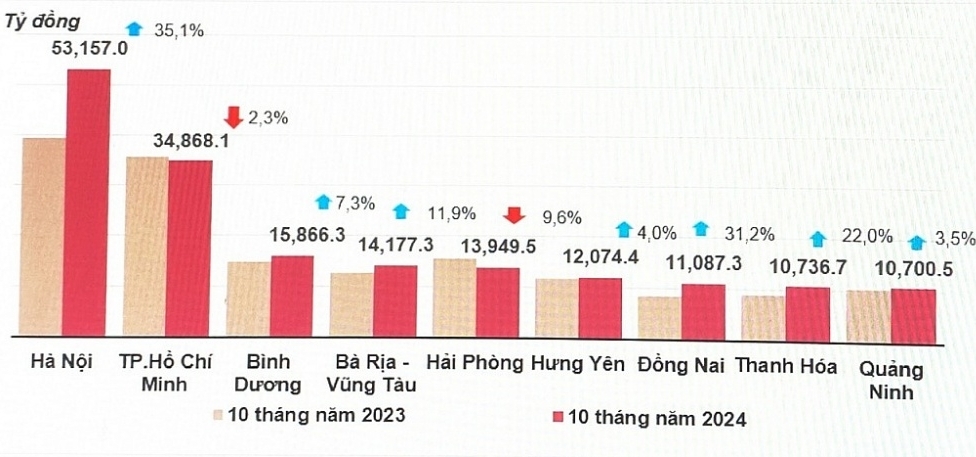Opening the door to developing the corporate bond market – Part 1: An important capital channel for the economy
| Tight but flexible regulations needed for healthy corporate bond market | |
| Potential for the green bond market in Vietnam | |
| Vaccine progress lift emerging East Asian Bond markets |
 |
| Corporate bonds are an important channel of capital for the economy. Source: Internet |
In the 2017-2020 period, besides positive factors, the development of the corporate bond market has revealed limitations and shortcomings.
In order for this market to develop sustainably, effectively and promote its role, the Government has completed a legal corridor for the market to follow the direction of openness, transparency and limit risks for private investors. The remaining issue is the compliance of market participants.
The strong growth of the corporate bond market has contributed to alleviating pressure on the banking system in providing long-term capital to the economy, reducing the ratio of short-term capital for medium- and long-term loans, promoting production and business activities of enterprises as well as the development of the economy.
Strong growth in size and value
Along with the development of the economy and the financial market, the bond market, including the corporate bond market, has been formed and gradually developed to meet the capital mobilization needs of the Government, policy of the State, local authorities and enterprises.
Formed in 2000, the corporate bond market has two components: corporate bonds issued to the public and corporate bonds issued privately.
But it wasn't until 2011 that the corporate bond market really developed. Along with the gradual improvement of the legal framework, the diversity of products and goods, the development of intermediary institutions, etc. in the 2011-2020 period, the bond market has developed in both dimensions.
In particular, the corporate bond market achieved an average growth rate of 26%/year, higher than the average growth rate of the bond market in general (24%/year). The corporate bond market size has also continuously grown, especially from 2018 onwards.
The annual report on Vietnam's bond market by the Ministry of Finance shows that, if in 2011, the corporate bond market's size reached 3.75% of GDP, in 2019 the size of the corporate bond market had a strong growth compared to other countries last year, an increase of about 31.2% compared to 2018, reaching about 10.85% of GDP.
This figure shows that enterprises have become more interested in the bond issuance channel to mobilize capital in addition to the bank credit channel. The corporate bond market size is estimated to reach more than 15% of GDP.
Thus, the growth of the corporate bond market has exceeded the target set out in Decision 1191/QD-TTg of the Prime Minister on approving the roadmap for the development of the bond market in the 2017-2020 period.
According to Do Bao Ngoc, Deputy General Director of Vietnam Construction Securities Joint Stock Company, corporate bonds are a very important capital channel for businesses as well as the economy, especially at this time.
There are too many choices because the issuance of shares to the public is not eligible for all enterprises, and bank credit lines have limited medium and long-term capital into real estate.
The report of the Ministry of Finance also shows that, in terms of issuance value, in the 2011-2018 period, the total volume of corporate bonds issued reached VND643,524 billion, the average issuance volume was about VND80,440 billion/year.
In 2019 alone, the total volume of corporate bonds issued reached VND332,852 billion, of which the private issuance reached VND309,352 billion, accounting for 92.9% of the issuance volume, and the issuance to the public was about VND23,500 billion, accounting for 7.1%. In 2019, Vietnam also had one enterprise that issued bonds to the international market with a volume of US$300 million.
Do Ngoc Quynh, General Secretary of the Vietnam Bond Market Association, said that in the past four years, the volume of successful corporate bond issuance has exceeded the volume of government bonds. On the other hand, in previous years, besides loosening policies on conditions and issuance procedures, Vietnam also allowed corporate bonds to choose the issuance method of individual bonds, which were also offered to the public for non-professional investors on the secondary market a year from the date of issue. This is the decision that causes the corporate bond market to explode in the 2019-2020 period.
“We opened the capital channel, the corporate bond market was gradually formed and merged into the capital market and the financial market. Enterprises can choose bond capital channel with medium and long-term capital sources and stable interest rates. Since then, businesses have invested in infrastructure, factories, and business activities of a long-term nature, helping the economy develop," said Do Ngoc Quynh.
Reducing the burden on the banking system
According to the Vietnam Bond Market Association, aggregated data on the HNX shows that in 2020, the total value of successfully issued corporate bonds is VND368,000 billion. This is the first time that the corporate bond market has surpassed the government bond market in terms of issuance volume (in 2020, the amount of government bonds issued by the State Treasury reached VND333,000 billion).
From the perspective of issuers, the Vietnam Bond Market Association said that in 2020, credit institutions and real estate companies are still the two types with the largest bond issuance value, accounting for 34% and 29% of the total issued value, respectively.
According to experts, although it is not new, in the past few years, the corporate bond market has developed, especially during the period when the State Bank (SBV) restricted credit in the real estate sector, leading to real estate enterprises promoting capital mobilization through corporate bond channels.
Financial expert Nguyen Tri Hieu said that corporate bonds are not only an important capital mobilization channel for businesses, but also a tool to reduce the burden on the banking system, because according to the SBV, outstanding loans of the economy in terms of GDP per capita is very large, about 150% of GDP, and most of it comes from the banking system. In that context, corporate bonds open up a new way out. Instead of going to banks to borrow money, businesses issue bonds themselves to mobilize capital.
According to research by the credit rating organization Fiin Ratings, in fact, in the last two years, a number of large enterprises such as Novaland (NVL), Vinhomes (VHM), An Gia Real Estate (AGG), World Real Estate Ky (CRE) actively shifted the loan structure from banks to corporate bond channels. Specifically, in the loan structure of Novaland Group in 2019, debt from corporate bonds accounted for 37%, in 2020 it is 53%.
This figure of Vinhomes, respectively, increased from 57% to 63%. With An Gia Real Estate and Century Real Estate, 100% of the debt in 2019 is a bank loan, but in 2020, the debt from corporate bonds of the two enterprises is 50% and 55%, respectively.
Tran Van The, Vice Chairman of Deo Ca Group, said that in the previous period, businesses focused and depended on credit, but due to the increasingly limited credit room for transport infrastructure, the bank tightened loans for BOT projects.
“So, this is the time to issue corporate bonds to implement transport projects in the form of public-private partnership (PPP). In September and October, Deo Ca will issue corporate bonds to implement the traffic projects that have just won the bid. In which, there are many national key projects. Typically, Cam Lam - Vinh Hao project - a component project of the North - South highway with a total investment of VND9,000 billion, Huu Nghi - Chi Lang project about VND7,500 billion, Dong Dang - Tra project Linh VND12,000 billion," Tran Van The said.
According to Fiin Ratings, the corporate bond channel will continue to play an important role in the strategy of restructuring capital and diversifying mobilization sources for businesses. Because the short-term cash flow of enterprises is weakened by the impact of the pandemic, enterprises need more time and capital to recover production and business activities as well as debt restructuring, while it is difficult for banks to meet enough long-term capital for enterprises. Therefore, continuing to seek long-term capital from the corporate bond channel is what will continue in 2021.
(Part 2: Potential risks)
Related News

Strengthening the financial “health” of state-owned enterprises
09:23 | 20/11/2024 Finance

Available foundations and drivers for strong economic growth
08:34 | 13/11/2024 Headlines

Public investment spending up 1.8% in first 10 months of 2024
10:03 | 08/11/2024 Finance

“New path” for small and micro enterprises to access capital
10:04 | 14/11/2024 Import-Export
Latest News

VN's food processing industry struggles to improve quality and value chain integration
15:53 | 22/11/2024 Import-Export

Approach strategy of the seafood industry when implementing UKVFTA
09:26 | 22/11/2024 Import-Export

Mid-November: Vietnam's trade volume matches 2023 total, eyes record-breaking growth
09:25 | 22/11/2024 Import-Export

Vietnamese enterprises facing challenges from cross-border e-commerce platforms
14:32 | 21/11/2024 Import-Export
More News

Vietnam, Malaysia eye new milestone in trade ties
14:29 | 21/11/2024 Import-Export
Shrimp exports surge in 10 months, generating 3.2 billion USD
14:27 | 21/11/2024 Import-Export

Vietnam’s exports to the U.S. near US$100 billion milestone
09:46 | 21/11/2024 Import-Export

From the “abnormal” coffee price, worries about the new crop
09:46 | 21/11/2024 Import-Export

What obstacles limit the market share of Vietnamese goods in the UK?
14:49 | 20/11/2024 Import-Export

Why seafood exports to some Middle Eastern Countries are stalled
14:47 | 20/11/2024 Import-Export

Storm No. 3 destroys profits of many insurance companies
14:45 | 20/11/2024 Import-Export

Vietnam, Malaysia eye golden partnership opportunities in Halal industry
14:44 | 20/11/2024 Import-Export

Tra fish sector aiming for production, processing greening for sustainable development
14:41 | 20/11/2024 Import-Export
Your care

VN's food processing industry struggles to improve quality and value chain integration
15:53 | 22/11/2024 Import-Export

Approach strategy of the seafood industry when implementing UKVFTA
09:26 | 22/11/2024 Import-Export

Mid-November: Vietnam's trade volume matches 2023 total, eyes record-breaking growth
09:25 | 22/11/2024 Import-Export

Vietnamese enterprises facing challenges from cross-border e-commerce platforms
14:32 | 21/11/2024 Import-Export

Vietnam, Malaysia eye new milestone in trade ties
14:29 | 21/11/2024 Import-Export





